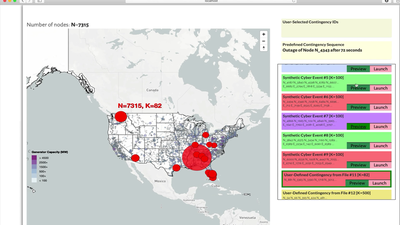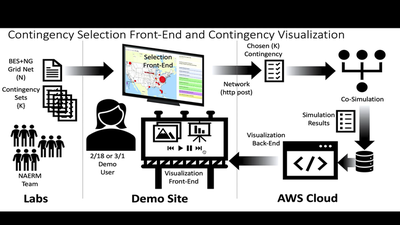NAERM
North American Energy Resilience Model provides the next generation planning infrastructure for the US national energy grid using a cloud-based real-time, interoperable, and federated modeling, simulation, and visualization technology.
Overview
](/kp/items/projects/naerm/naerm-layers_hua58199de63f4b4e6b94d8be590c7933b_1750092_f77a2182ff45df2bdd162ee5771a05ba.png)

Contributions
As ORNL lead for the NAERM Software Architecture Group, my efforts were focused on enabling cloud-based federated simulations executing in a distributed fashion across PNNL, ORNL and ANL servers. In particular, a dynamically configured and launched network of virtual machines via Amazon Web Services (AWS), coordinated using AWS Step Functions. Automated launches of electric transmission grid scenarios can be triggered in a highly responsive fashion. The software architecture was designed to evaluated using the Siemens PSS/E simulator instances that were licensed to execute in on-premise mode only at ORNL. Additionally, PowerWorld simulations were dynamically interoperated with other instances using federated simulation interfaces of the HELICS system for interfacing with gas network outage models simulated at ANL.
A contingency visualization, selection and launch tool was developed with one of my team members (Dr. Maksudul Alam).
Architecture

Demo Videos
{{< youtube Nzu2louHPFY >}}
Description
The NAERM will ultimately provide real-time situational awareness and analysis capabilities for emergency events for optimal operations and recovery, so that the Federal Government can quickly and effectively prepare and respond, for example, providing recommendations in coordination with State and local governments, Federal Emergency Management Agency (FEMA), and the National Guard. While the primary focus is on the energy sector, the NAERM will further assist industry in assessing the resilience implications of energy planning decisions on associated infrastructure. NAERM capabilities will also be leveraged by DOE’s National Nuclear Security Administration (NNSA), the Department of Defense (DoD), and the Department of Homeland Security (DHS) in support of their national security missions.
– NAERM Report
The North American Energy Resilience Model project is focused on developing the next generation planning infrastructure for the US national energy grid using a cloud-based real-time, interoperable, and federated modeling, simulation, and visualization technology
Ultimately, NAERM will enable DOE’s provision of situational assessment advice to industry and government to ameliorate the risk of and consequence associated with large- scale service disruptions across infrastructure sectors—and geographic and organizational boundaries—and the lengthy restoration and recovery operations following an extreme event. The NAERM will advance the state-of-science in planning and operations of energy supply in extreme events and provide rigorous resilience and associated economics metrics for these sectors.
– NAERM Report
Organization
- Sponsor: US Department of Energy (DOE)
- Office: Office of Electricity (OE)
- Program: North American Energy Resilience Model (NAERM)
- Team: ORNL, PNNL, LLNL, ANL, and others